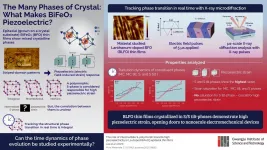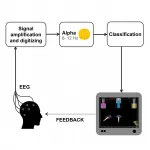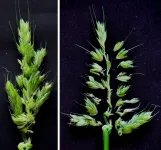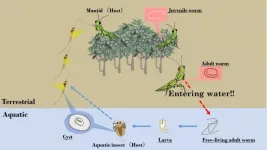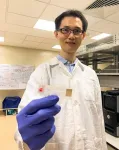Diversity of tiny bobtail squid driven by ancient biogeographic events, finds new study
2021-06-29
(Press-News.org) Bobtail and bottletail squids are tiny marine invertebrates that are found throughout the world's oceans and are useful model animals for research
There are 68 recognized species of bobtail squid and five recognized species of bottletail squid, but the timing of their divergence from one another is still relatively unknown
Researchers at OIST, Hiroshima University and the National University of Ireland Galway, collected 32 species of bobtail and bottletail squids
They looked at the genetic variations across the entire genomes of these species to estimate their evolutionary relationships
The results showed that the divergence of these species aligned with major biogeographic events such as a global mass extinction and the division between the Indo-Pacific Sea and the Atlantic Ocean.
Bobtail and bottletail squids are small marine invertebrates that are easy to collect, reproduce quickly, and can be raised together in large numbers in laboratories, making them useful model animals for research. They're cephalopods--related to true squid, octopus, and cuttlefish, which are renowned for their intelligence and complex behaviors, but of which scientists still know little about. Now, in a new study, published in Communications Biology, researchers have used genetic techniques to show that bobtail squid and bottletail squid share a relatively recent common ancestor and that major biogeographic events might have shaped the evolution of the many different species.
"With 68 recognized species, bobtail squid are a very diverse family and split into three subfamilies. This study found that one of these subfamilies is further split into two geographic lineages." explained one of the lead authors, Dr. Gustavo Sanchez, researcher at Hiroshima University and former Visiting Research Student in the Okinawa Institute of Science and Technology Graduate University's (OIST) Molecular Genetics Unit. "In 2019, as part of my previous research at OIST, we described a new species of bobtail squid, which highlights both the diversity present and that many unknowns remain."
Bobtail and bottletail squids make up the order Sepiolida. They're small, normally between 1 and 8 cm, and live in a range of marine habitats around the globe, from shallow coastal waters to the open ocean.
For this new study, Dr. Sanchez, alongside researchers from OIST and the National University of Ireland Galway, collected 32 species of bobtail and bottletail squids from across the Indo-Pacific, the Mediterranean Sea, and the Atlantic Ocean. They use a technique called genome skimming that sequences whole genomes, albeit at low coverage. This allowed them to look at the genetic variations between these species so they could estimate their evolutionary relationships and when they diverged.
Their results revealed that bobtail and bottletail squids split into different families around 66 million years ago. This aligns with the rapid diversification of modern marine fishes, following the disappearance of more ancient groups due to a global mass-extinction (the same one that wiped out most of the dinosaurs). Bobtail squid went on to further diversify into three subfamilies--Sepiolinae and the more closely related Rossinae, and Heteroteuthinae. The researchers found that Sepiolinae, which makes up the largest of these subfamilies, can be further split into two tribes--those that are found in the Indo-Pacific Ocean and those that are found in the Mediterranean Sea and the Atlantic Ocean. This split coincided with another major biogeographic event--the closure of the Tethys Sea, around 50 million years ago, which generated the separation of these two regions and resulted in this subfamily being split in two.
A second interesting part of this study focused on the evolution of a light organ in bobtail squid that allows the production of luminescence. Producing luminescence is important for the survival of many of these animals as it allows for counter-illumination, which keeps them hidden from predators at night. The researchers found that the ancestor of the Sepiolinae subfamily likely possessed a bilobed light organ that housed luminescence-producing symbiotic bacteria. This has been retained by many of the species that exist today but was lost in two groups--one in the Indo-Pacific tribe and the other in the Mediterranean-Atlantic tribe.
"The evolutionary relationship of nearly 50% of bobtail squid still needs to be investigated but this research has provided a reliable foundation for classifying bobtail and bottletail squids," said Prof. Daniel Rokhsar, who leads the OIST Unit. "We hope that this phylogenetic work and ancestral reconstructions will be useful in future studies."
INFORMATION:
[Attachments] See images for this press release:

ELSE PRESS RELEASES FROM THIS DATE:
2021-06-29
Tel Aviv University's groundbreaking technology may revolutionize the treatment of cancer and a wide range of diseases and medical conditions. In the framework of this study, the researchers were able to create a new method of transporting RNA-based drugs to a subpopulation of immune cells involved in the inflammation process, and target the disease-inflamed cell without causing damage to other cells.
The study was led by Prof. Dan Peer, a global pioneer in the development of RNA-based therapeutic delivery. He is Tel Aviv University's Vice President for Research and Development, head of the Center for Translational Medicine and a member of both the Shmunis School of Biomedicine and Cancer Research, George S. Wise Faculty ...
2021-06-29
What if electricity could be squeezed out of something? It turns out some materials have this property. Piezoelectricity is the electric charge that accumulates in certain solids when mechanical stress is applied on them. Piezoelectric materials, like bismuth ferrite thin films, when grown on a single lanthanum aluminate substrate give rise to highly strained epitaxial thin films that exhibit excellent electromechanical and ferroelectric properties. In bismuth ferrite thin films "doped" or polluted with lanthanum (BLFOs), piezoelectricity is attributed to the presence of "mixed-phase structures" with stripe patterns.
The formation of stripe patterns and controlling the mixed-phase structures of BLFO have been the ...
2021-06-29
A FLEET theoretical study out this week has found a 'smoking gun' in the long search for the topological magnetic monopole referred to as the END ...
2021-06-29
HARWELL, UK (29 June 2021) Researchers working on the Faraday Institution project on the recycling of lithium-ion batteries (ReLiB) at the Universities of Leicester and Birmingham have solved a critical challenge in the recovery of materials used in electric vehicle batteries at the end of their life, enabling their re-use in the manufacture of new batteries. The new method, which uses ultrasonic waves to separate out valuable material from the electrodes, is 100 times quicker, greener and leads to a higher purity of recovered materials relative to current separation methods.
The research has been published in Green Chemistry and the team have applied for a patent for the technique.
To ...
2021-06-29
Patients with mild Covid-19 infections experience a significantly increased longer lasting reduced sense of taste and smell. This is also the case for long-term shortness of breath, although relatively few people are affected. And women and the elderly are particularly affected. This is shown by new research findings from Aarhus University Aarhus University Hospital and Regional Hospital West Jutland
The last 14 months have taught us that there are different symptoms and outcomes of Covid-19. However, the vast majority of people who fall ill with Covid-19 experience mild symptoms and get over ...
2021-06-29
Attention Deficit Hyperactivity Disorder (ADHD) affects about 7% of children, with a two out of three chance of persisting into adulthood. This neurodevelopmental disorder is characterised by concentration difficulties, increased distractibility, impulsivity and hyperactivity. Today, ADHD is treated with pharmaceutical drugs that may have unwanted side effects. This is why scientists from the University of Geneva (UNIGE) and the University Hospitals of Geneva (HUG), Switzerland, explored a new technique called 'neurofeedback', which enables ADHD patients to train their attention, based on instant feedback from the level of their brain activity. The team of neuroscientists found that not only did the training have a positive effect on patients' concentration abilities, but also that the ...
2021-06-29
An international team of researchers has identified a novel mechanism in barley plants, which could help crop growers achieve high yields as temperatures rise.
With grain production highly sensitive to changing environmental conditions, rising temperatures are known to reduce the number of seeds that can be produced on each plant. One solution is to increase the number of flowers or branches on each 'spike', which is the reproductive structure from which grain is harvested.
In a study published in Nature Plants, research led by Professor Dabing Zhang from the University of Adelaide's Waite Research Institute and Shanghai Jiao Tong University's Joint Lab for Plant Science and Breeding, explored the possibility of increasing seed production through ...
2021-06-29
Tsukuba, Japan - As far back as the 1930s, inventors have commercialized fuel cells as a versatile source of power. Now, researchers from Japan have highlighted the impressive chemistry of an essential component of an upcoming fuel cell technology.
In a study recently published in The Journal of Physical Chemistry Letters, researchers from the University of Tsukuba have revealed successive proton transport--energy transfer--in an advanced carbon-based crystal for future fuel cells, and the chemistry that underpins this phenomenon.
Such crystals are exciting as solid electrolytes--energy transfer media--in upcoming fuel cell technologies. Solid electrolytes have advantages, such as high power efficiency and long-term ...
2021-06-29
Researchers have revealed that praying mantis (mantids) infected with parasitic hairworms are attracted to horizontally polarized light that is strongly reflected off the surface of water, which causes them to enter the water. In a world-first, these research results demonstrate that parasites can manipulate the host's specific light perception system to their advantage, causing the host to behave in an abnormal manner.
This discovery was made by an international research group consisting of Graduate student OBAYASHI Nasono, Associate Professor SAKURA Midori and Associate Professor SATO Takuya of Kobe University's Graduate School of Science, Associate Professor IWATANI Yasushi (Faculty of Science and Technology, Hirosaki University), ...
2021-06-29
A team of scientists from Nanyang Technological University, Singapore (NTU Singapore) has developed a test kit for malaria that delivers results in 30 minutes. The kit could facilitate the diagnosis of malaria in the field, as the equipment needed is anticipated to be lightweight, easy-to-use, and able to detect the disease in its early stages.
According to the World Health Organisation (WHO), an estimated 229 million people suffered from malaria in 2019. The disease, transmitted by mosquitoes, caused the deaths of 409,000 people across 87 mainly developing countries.
Efforts to treat and control malaria in ...
LAST 30 PRESS RELEASES:
[Press-News.org] Diversity of tiny bobtail squid driven by ancient biogeographic events, finds new study

